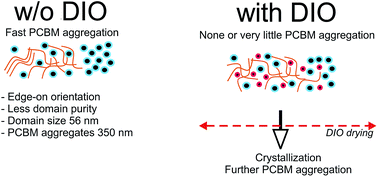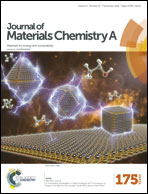Controlling additive behavior to reveal an alternative morphology formation mechanism in polymer : fullerene bulk-heterojunctions†
Abstract
One of the most employed morphology optimization methods to design better performing organic photovoltaic devices is ink formulation engineering with additives. In this work, by employing a suboptimal host solvent mixture and 1,8-diiodooctane (DIO) as a very optimal solvent for both components in poly-thieno[3,2b]thiophene-diketopyrrolopyrrole-co-thiophene (DPP-TT-T)-based bulk-heterojunctions (BHJ), an alternative, previously unknown mechanism of additive behavior on BHJ microstructure formation is presented. In situ characterization methods involving grazing incidence X-ray diffraction, white-light reflectometry, laser light scattering and photoluminescence during film drying reveal that the microstructure formation under the influence of DIO is led towards thermodynamic equilibrium during host solvent drying, and the kinetics of morphology formation (i.e. polymer crystallization, fullerene aggregation…) are controlled dominantly by the additive during its evaporation. Ex situ X-ray-based characterization methods, such as scanning transmission X-ray microspectroscopy (STXM) and resonant soft X-ray scattering (R-SoXS), additionally reveal that the microstructure of dried films favors smaller domain sizes with purer domains, smaller fullerene aggregates, bimodal polymer crystallization relative to the substrate and more face-on molecular orientation relative to the donor/acceptor interface, which at the end lead to better performing devices with power conversion efficiencies ranging from 1.25% to 4.68%.



 Please wait while we load your content...
Please wait while we load your content...